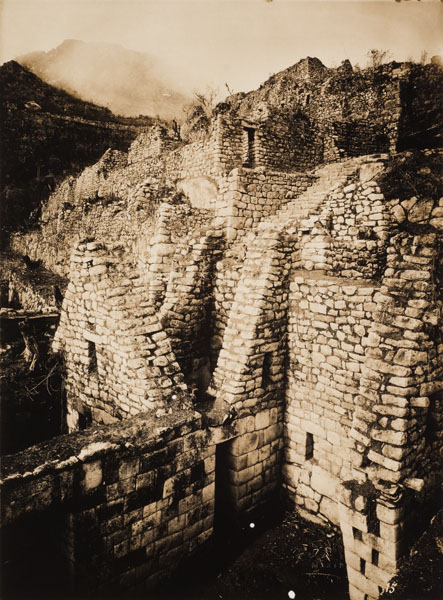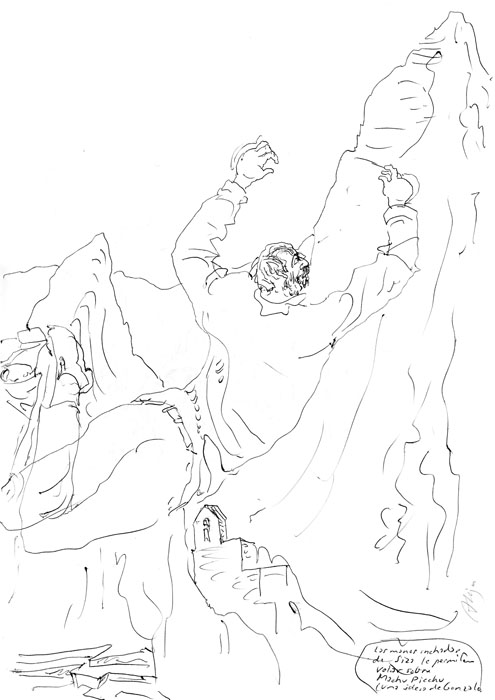Pens and Lenses: Alturas de Macchu Picchu at the CCA

Martín Chambi, Partial view of the King's Group showing the courtyard, Macchu Picchu, Peru, 1927. CCA Collection © Archivo Fotografico Martín Chambi
Alturas de Macchu Picchu: Martín Chambi—Álvaro Siza at work, now in its final week at the Canadian Centre for Architecture's Octagonal Gallery, is explicit about the subjective nature of putting works on display. In this case, it's a selection of Peruvian photographer Martín Chambi's 1920s portraits of the ancient Inca ruins, presented alongside a collection of Portugese architect Álvaro Siza's sketches from a 1995 visit to the site.
While many of Siza's sketches portray the stonework and landscapes around the ruins, he's also comfortable letting his mind wander. For instance, one page features a design for a family tombstone, another, entitled "Night Sky," is composed purely of pen blotches that bled through from the previous page. Then there's a more whimsical sketch in which Siza draws himself flying over top of the ruins (likely not to scale).

Álvaro Siza, Sketch from notebook #399, Macchu Picchu, Peru, 1995. © Álvaro Siza, Architect
With so much off-topic drawing, it may appear as though the photographs serve to validate representations of the ruins in the sketches. Yet there's plenty of subjectivity present in Chambi's photographs, too. He not only chooses what to capture and what to ignore, but also wields considerable skill in the darkroom: a hazy quality permeates the photos, and he plays tricks with light. Unearthing these biases strengthens the exhibit, turning on its head the idea that a particular method of documenting reality is "more valid" than another. Indeed, it's not so much the ruins that are explored, but the different ways of seeing them.
David Covo, an architecture professor at McGill who saw the exhibit when it first opened, noted that Siza was concerned with this idea in his writings, exploring the difference between looking and seeing in Portugese. Covo attempts to do the same thing when discussing when it's appropriate to use photographs or sketches. "The two media are complementary," he says. "Understanding how each of the media mitigates our experience of the world is a wonderful challenge."
The exhibit skillfully questions how process affects results. Yet the works are also a pleasure to simply look at, and the layout of the room facilitates a comparison of the two. In Covo's words, "The wonderful thing about those photographs is that they have an almost painterly quality—they're not snapshots, they share many of the qualities of searching that we have in Siza's sketches."
In the middle of the room, another display features a case study of Siza's work: a public housing project in Evora, Portugal. Started in 1977, it is now home to 10 percent of the city's population, including the architect himself. The only design-oriented connection to the main exhibit is contained in a sketch of some intricate stonework at Macchu Picchu. The detailed drawing suggests Siza was so enamored with the piece that an adapted version of it made its way into one of the project's public parks after his visit.
One distinguishing feature of the housing project is that residents are encouraged to adapt their homes in subtle ways to suit their evolving needs. Acting as an in-house consultant, Siza can facilitate changes to homes as requested by other inhabitants. (Regrettably, a promised mix of services has not arrived, meaning the project provides a lot of housing, but little else.)
It doesn't appear, however, that much heterogeneity exists from one house to another. Exhibit curator Fabrizio Gallanti reasons that a "serendipitous effect of similarity" spread among residents, insisting that no single top-down view of the site was imposed on them. And so a sense of self-empowerment bubbles beneath the surface of Alturas de Macchu Picchu, though you have to work to see it.
Macchu Picchu: Martín Chambi—Álvaro Siza at work runs until April 29 at the CCA. Siza will also give a lecture on Thursday, April 26 at 7 pm at the CCA.
Subscribe to Maisonneuve today.
Related on maisonneuve.org:
—The Political Legacy of Argentina's Graffiti
—New Remedies: Imperfect health at the CCA
—Journeys at the CCA: The Architecture of Migration





